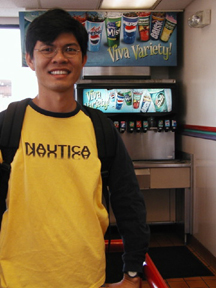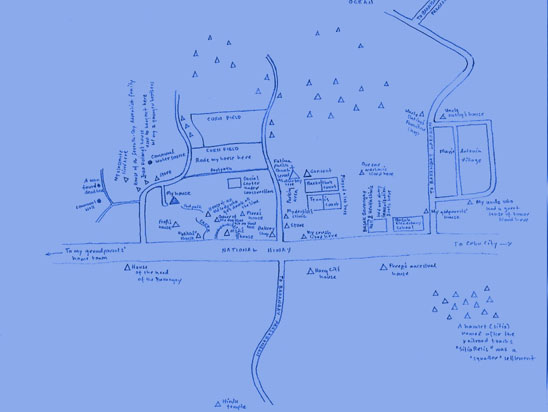|
|

My name is Aloysius Canete, a.k.a., Aloy. I was born and raised in
Cebu City, south of the capital Manila. It is not only the second
most populous city, but also the oldest city in the Philippines. As
you can tell, my citizenship is Filipino, but I am a Cebuano, one of
the 80 plus ethno-linguistic groups in the Philippines. Prior to my
US adventure, I taught at a university in Cebu City for eight years.
Since 2003, I am pursuing a Ph.D degree in socio-cultural
anthropology at ASU. My research focuses on ethniCity and urban
development in the postcolonial Philippines. In my spare time, I go
to used bookstores, Lee Lee's Oriental Store and watch good films. I
am also a big fan of Kurosawa, Fellini, and Antonioni.
My
Memory Map
Basak is the name of the barangay (village) in which
I grew up. It is one of the 27 barangays that make up Mandaue City,
the second highly urbanized city in the province of Cebu today. The
word basak comes from the Cebuano word basakan which
means “field.” In the Philippines, it is not uncommon to name a
place after a river, a tree, or a field as in the case of my
barangay. No wonder, my friend’s grandmother who spent all her life
in Basak used to tell me that scores of corn fields were found in
the village, including the land where my house stood. Although
there was not much left of what was once a village full of corn
fields, at least during my childhood days, one could still see
vestiges of them in a landscape filled with a lot of empty plots.
 |
But Basak was not only about dwindling number of corn
fields. Four years after we moved in to our newly built
house, the barangay chapel became a parish church with Our
Lady of Fatima as patron saint. The establishment of the
parish church in my neighborhood changed my life. For one,
I became an altar boy, which was not uncommon for boys at my
age in the Philippines to do. But on hindsight, I have to
admit that being an altar boy is not the most exciting part
of having a parish in my area. It was the annual barangay
fiesta in which the whole place came to life as people from
different walks of life, rich and poor, young and old, men
and women, celebrated the event. The parking ground of the
church metamorphosed into a carnival while the basketball
court became an open air cinema at night opened to everyone
free of charge. Suspended in time and space, it was during
this time of the year when the whole place turned magical,
everyone in a state of liminality. |
Aside from the parish church, communal sources of water
were important sites where people congregated in my neighborhood.
Everyone in my neighborhood relied on the communal water sources,
save for the family of Mik and that of the professor who could
afford to have their own water system installed in their houses.
Although fetching water was hard work for me, I must say that it was
fun, especially taking a bath playfully with other kids at the
communal water site. Normally, my brothers and I preferred to pump
water by hand, but when such water station was crowded, we were
forced to fetched water at the communal well. But when a man was
found dead next to the well, we stopped fetching water there ever
since that happened.
Twenty-five years later, not only my house looked
different, but also the entire neighborhood. Since I graduated from
college, my parents made some improvements to the house. The house
is now bigger, fancier, and, yes, has a constant supply of water in
the house, thanks to the Metro Cebu Water District. My parents are
now drinking tap water and taking a shower in the bathroom. My
neighborhood has changed a lot too since the past twenty-five
years. It has now a name called Palm Hills Subdivision, a name
bearing the imprimatur of the developer of the subdivision. One of
the last two remaining corn fields is currently a Montessori school
while a factory sits on the other. The people living in the
“squatter” settlement called sitio (hamlet) Relis was evicted
10 years ago to pave the way for another subdivision. The parish
priest decided to do away with both the tennis and the basketball
courts in order to have more parking space as more and more rich
people with cars lived in Basak. And commercial buildings have
replaced the empty spaces along the opposite side of the national
road from my neighborhood. Have you been wondering what happened to
the communal sources of water? They are obviously gone and erased
from the memory of my neighborhood to give way to western-style
houses built for the middle class.
Every time I wandered around what used to be my
neighborhood, I could not help but feel nostalgic about the days
when I was growing up here. But I have to admit that the place I
once called home is now different and the disconnect between me and
my neighborhood is a testament to that. |